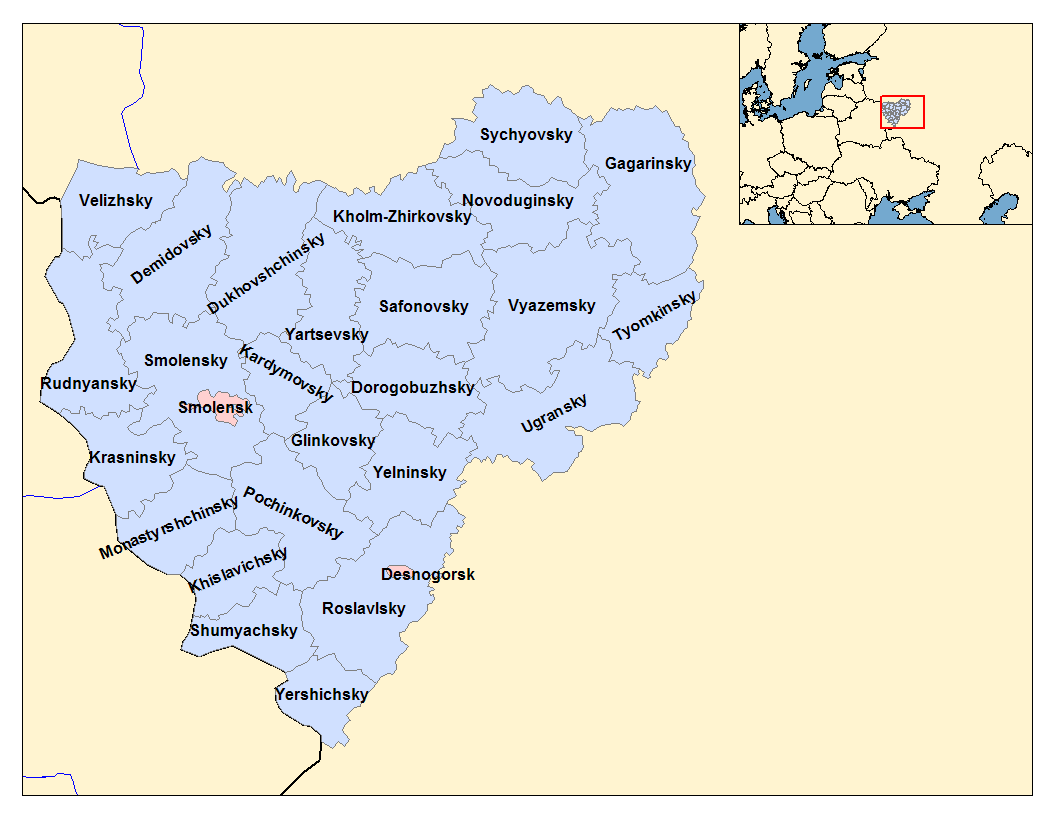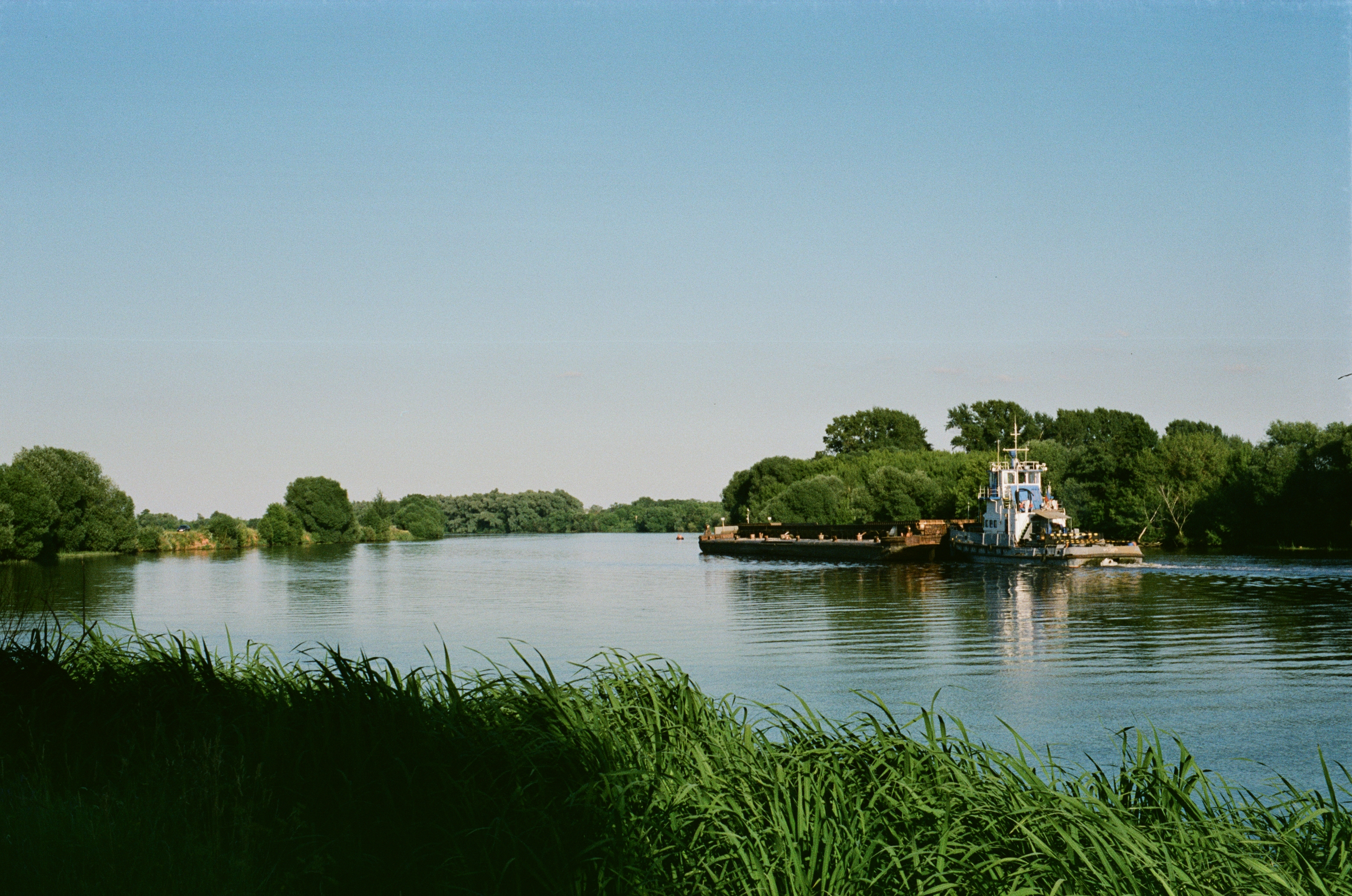|
Smolensk Upland
The Smolensk Upland (russian: italic=yes, Смоленская возвышенность) is the Western part of the Smolensk–Moscow Upland at the East European Plain, which is located mainly in Smolensk Oblast of Russia, with small parts lying in Moscow and Kaluga Oblasts of Russia and in Vitebsk Region of Belarus. The highest point, located close to the city of Vyazma, is . The Smolensk Upland is divided between the drainage basins of the Volga (east) and the Dnieper } The Dnieper () or Dnipro (); , ; . is one of the major transboundary rivers of Europe, rising in the Valdai Hills near Smolensk, Russia, before flowing through Belarus and Ukraine to the Black Sea. It is the longest river of Ukraine and ... (east). A number of big rivers have their sources in the upland. These include the Dnieper, the Desna, the Vazuza, and the Moskva. References {{reflist Geography of Smolensk Oblast Hills of Russia Geography of Moscow Oblast Geography of Vitebsk Region ... [...More Info...] [...Related Items...] OR: [Wikipedia] [Google] [Baidu] |
Volga River
The Volga (; russian: Во́лга, a=Ru-Волга.ogg, p=ˈvoɫɡə) is the longest river in Europe. Situated in Russia, it flows through Central Russia to Southern Russia and into the Caspian Sea. The Volga has a length of , and a catchment area of «Река Волга» , Russian State Water Registry which is more than twice the size of . It is also Europe's largest river in terms of average at delta – between and – and of drainage basin. It is widely regarded as ... [...More Info...] [...Related Items...] OR: [Wikipedia] [Google] [Baidu] |
Hills Of Russia
A hill is a landform that extends above the surrounding terrain. It often has a distinct summit. Terminology The distinction between a hill and a mountain is unclear and largely subjective, but a hill is universally considered to be not as tall, or as steep as a mountain. Geographers historically regarded mountains as hills greater than above sea level, which formed the basis of the plot of the 1995 film ''The Englishman who Went up a Hill but Came down a Mountain''. In contrast, hillwalkers have tended to regard mountains as peaks above sea level. The ''Oxford English Dictionary'' also suggests a limit of and Whittow states "Some authorities regard eminences above as mountains, those below being referred to as hills." Today, a mountain is usually defined in the UK and Ireland as any summit at least high, while the official UK government's definition of a mountain is a summit of or higher. Some definitions include a topographical prominence requirement, typically or ... [...More Info...] [...Related Items...] OR: [Wikipedia] [Google] [Baidu] |
Geography Of Smolensk Oblast
Smolensk Oblast (russian: Смоле́нская о́бласть, ''Smolenskaya oblast''; informal name — ''Smolenschina'' (russian: Смоле́нщина)) is a federal subject of Russia (an oblast). Its administrative centre is the city of Smolensk. As of the 2010 Census, its population was 985,537. Geography The oblast was founded on 27 September 1937.Исполнительный комитет Смоленского областного совета народных депутатов. Государственный архив Смоленской области. "Административно-территориальное устройство Смоленской области. Справочник", изд. "Московский рабочий", Москва 1981. Стр. 8 It borders Pskov Oblast in the north, Tver Oblast in the northeast, Moscow Oblast in the east, Kaluga Oblast in south, Bryansk Oblast in the southwest, and Mogilev and Vitebsk Oblas ... [...More Info...] [...Related Items...] OR: [Wikipedia] [Google] [Baidu] |
Moskva River
The Moskva (russian: река Москва, Москва-река, ''Moskva-reka'') is a river running through western Russia. It rises about west of Moscow and flows roughly east through the Smolensk and Moscow Oblasts, passing through central Moscow. About southeast of Moscow, at the city of Kolomna, it flows into the Oka, itself a tributary of the Volga, which ultimately flows into the Caspian Sea. History In addition to Finnic tribes, the Moskva River is also the origin of Slavic tribes such as the Vyatichi tribe. Etymology ''Moskva'' and ''Moscow'' are two different renderings of the same Russian word ''Москва''. The city is named after the river. Finnic Merya and Muroma people, who originally inhabited the area, called the river ''Mustajoki'', in English: ''Black river''. It has been suggested that the name of the city derives from this term, although several theories exist. To distinguish the river and the city, Russians usually call the river ''Moskva-re ... [...More Info...] [...Related Items...] OR: [Wikipedia] [Google] [Baidu] |
Vazuza River
The Vazuza (russian: Вазу́за), a river in the Novoduginsky and Sychyovsky districts of Smolensk Oblast and in the Zubtsovsky District of Tver Oblast, Russia, becomes a right tributary of the Volga. It is long, and its drainage basin covers . Soviet engineers flooded the lower part of the river to form the Vazuza Reservoir. The towns of Sychyovka and Zubtsov are located on the banks the Vazuza (the latter at its confluence with the Volga). The main tributaries of the Vazuza are the Kasnya, the Gzhat (both right), the Losmina and the Osuga (left). The source of the Vazuza is located east of the village of Lukino in Novoduginsky District. The river flows north, crosses into Sychyovsky District, and downstream of the town of Sychyovka turns east. Several kilometers downstream from Sychyovka the reservoir begins, and all major tributaries of the Vazuza form bays in the reservoir. The Vazuza accepts the Kasnya from the right and turns northeast. Downstream of the mouth ... [...More Info...] [...Related Items...] OR: [Wikipedia] [Google] [Baidu] |
Desna River
The Desna (russian: Десна́; uk, Десна) is a river in Russia and Ukraine, a major left- tributary of the Dnieper. Its name means "right hand" in the Old East Slavic language. It has a length of , and its drainage basin covers .Десна Great Soviet Encyclopedia. In Ukraine, the river's width ranges from , with its average depth being . The mean annual discharge at its mouth is . The river freezes over from early December to early April, and is navigable from to its mouth, a length of about . The water level of the river reached its lowes ... [...More Info...] [...Related Items...] OR: [Wikipedia] [Google] [Baidu] |
Dnieper
} The Dnieper () or Dnipro (); , ; . is one of the major transboundary rivers of Europe, rising in the Valdai Hills near Smolensk, Russia, before flowing through Belarus and Ukraine to the Black Sea. It is the longest river of Ukraine and Belarus and the fourth- longest river in Europe, after the Volga, Danube, and Ural rivers. It is approximately long, with a drainage basin of . In antiquity, the river was part of the Amber Road trade routes. During the Ruin in the later 17th century, the area was contested between the Polish–Lithuanian Commonwealth and Russia, dividing Ukraine into areas described by its right and left banks. During the Soviet period, the river became noted for its major hydroelectric dams and large reservoirs. The 1986 Chernobyl disaster occurred on the Pripyat, immediately above that tributary's confluence with the Dnieper. The Dnieper is an important navigable waterway for the economy of Ukraine and is connected by the Dnieper–Bug Ca ... [...More Info...] [...Related Items...] OR: [Wikipedia] [Google] [Baidu] |
Vyazma
Vyazma (russian: Вя́зьма) is a town and the administrative center of Vyazemsky District in Smolensk Oblast, Russia, located on the Vyazma River, about halfway between Smolensk, the administrative center of the oblast, and Mozhaysk. Throughout its turbulent history, it defended western approaches to Moscow. Population: 44,000 (1970). Medieval history and monuments Vyazma was first mentioned in a chronicle under the year of 1230, although it is believed to be much older than that. The town was named after the river, whose name was from Russian word "" (''vyaz), meaning "bog" or "swamp".Е. М. Поспелов. "Географические названия мира". Москва, 1998, стр. 108. At the time, the town belonged to a lateral branch of the Rurikid House of Smolensk, and carried on a lively trade with Narva on the Gulf of Finland. In 1403, the local princes were expelled by Lithuanians to Moscow, where they took the name of Princes Vyazemsky. The ... [...More Info...] [...Related Items...] OR: [Wikipedia] [Google] [Baidu] |
Smolensk–Moscow Upland
The Smolensk–Moscow Upland is located in the Yaroslavl, Vladimir, Moscow and Smolensk regions of Russia, as well as the Vitebsk region of Belarus. Geography It stretches from southwest to northeast from the Belarusian city of Orsha to Yuriev-Polsky. It consists of the Smolensk Upland (western part) and the Moscow Uplands (eastern part). It extends 500 km. Its highest point is 320 m (northeastern part of Smolensk). The terrain is hilly, erosion-moraine. In the west the moraine chain goes to the Belarusian ridge . The Dnieper (west) and the Volga (east) rivers drain its hill. The watersheds feed three seas: the Baltic (Kasplya → Western Dvina), Black (Dnieper) and the Caspian (the Volga, the Oka River and their tributaries). Ecology It is covered with mixed forests, dominated by spruce and birch. Peat bogs are also present. Its soils are mainly sod-podzolic, loam Loam (in geology and soil science) is soil composed mostly of sand (particle size > ), silt (pa ... [...More Info...] [...Related Items...] OR: [Wikipedia] [Google] [Baidu] |
Belarus
Belarus,, , ; alternatively and formerly known as Byelorussia (from Russian ). officially the Republic of Belarus,; rus, Республика Беларусь, Respublika Belarus. is a landlocked country in Eastern Europe. It is bordered by Russia to the east and northeast, Ukraine to the south, Poland to the west, and Lithuania and Latvia to the northwest. Covering an area of and with a population of 9.4 million, Belarus is the 13th-largest and the 20th-most populous country in Europe. The country has a hemiboreal climate and is administratively divided into seven regions. Minsk is the capital and largest city. Until the 20th century, different states at various times controlled the lands of modern-day Belarus, including Kievan Rus', the Principality of Polotsk, the Grand Duchy of Lithuania, the Polish–Lithuanian Commonwealth, and the Russian Empire. In the aftermath of the Russian Revolution in 1917, different states arose competing for legitimacy amid the ... [...More Info...] [...Related Items...] OR: [Wikipedia] [Google] [Baidu] |
Vitebsk Region
Vitebsk Region or Vitebsk Oblast or Viciebsk Voblasts ( be, Ві́цебская во́бласць, ''Viciebskaja voblasć'', ; rus, Ви́тебская о́бласть, Vitebskaya oblast, ˈvʲitʲɪpskəjə ˈobləsʲtʲ) is a region ( oblast) of Belarus with its administrative center being Vitebsk. It is located near the border with Russia. As of a 2019, the region had a population of 1,135,731. It has the lowest population density in Belarus at 30.6 p/km². Important cities within the region include Vitebsk, Orsha, Polotsk, and Novopolotsk. Geography Vitebsk Region covers an area of 40,000 km², which is about 19.4% of the national total. It is bordered on the north by Pskov Oblast of Russia, by Smolensk Oblast of Russia on the east, on the south by Minsk Region and by Mogilev Region, on the southwest by Minsk Region and Grodno Region, and on the west and northwest by Vilnius and Utena counties of Lithuania and Augšdaugava, Krāslava and Ludzamunicipa ... [...More Info...] [...Related Items...] OR: [Wikipedia] [Google] [Baidu] |







